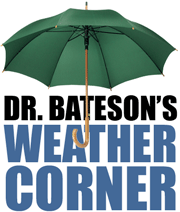
Dr. Owen Bateson, our resident meteorological expert, has recorded only .21 inches of rain during the month of January – that’s only .07% of average precipitation for the month.
Bateson explains, “We have only had 4.76 inches of moisture since July first for a whopping 40% of average which is down from 51% on December 31st.”
Why So Dry?
“The calendar year 2013 was the driest on record for California,” says Bateson, “These records date back 165 years to 1849 when San Francisco started recording precipitation events, so this is an unprecedented drought.”
“There is a huge high pressure ridge that has anchored itself in the eastern Pacific ocean over the past 13 months that is over 21,000 feet high and 2000 miles long that pushes the winter storms up to Alaska and essentially blocks them from affecting California and southern Oregon.”
“These storms then descend down through Canada and enter the mid-west states which has created the coldest and nastiest winter in the mid-west and northeastern states in the past 20 years.”
According to Bateson the atmospheric envelope surrounding the earth is not of uniform thickness and it is the difference in the height of the atmosphere that creates low and high pressure areas which greatly affects our weather. High pressure areas or systems have a higher column of air than a low pressure system and therefore has more weight of the molecules of air pressing on the ground which is measurable with a Barometer.
“A high pressure area is normally associated with colder and drier air than a low pressure area and normally creates better weather and clearer skies while the lower pressure areas does the opposite, with cloudy, stormy and wetter weather.”

“It is this cyclonic counter-clockwise flow of air that caused an unprecedented winter dust storm on January 23rd from the Black Rock Desert,” says Bateson, “due to what is referred to as a Tonopah low.”
Weather experts are scratching their heads however over the very persistent high pressure ridge off California that is causing our severe drought. No one alive today has ever lived through a worse drought than this one in California.
“We seem to be caught between the ‘El Nino’ phenomenon and the ‘La Nina’ phenomenon in the eastern Pacific,” said Bateson, “and the bad news is that it is predicted to stay about the same through the summer of 2014 and prolonging our drought.”




